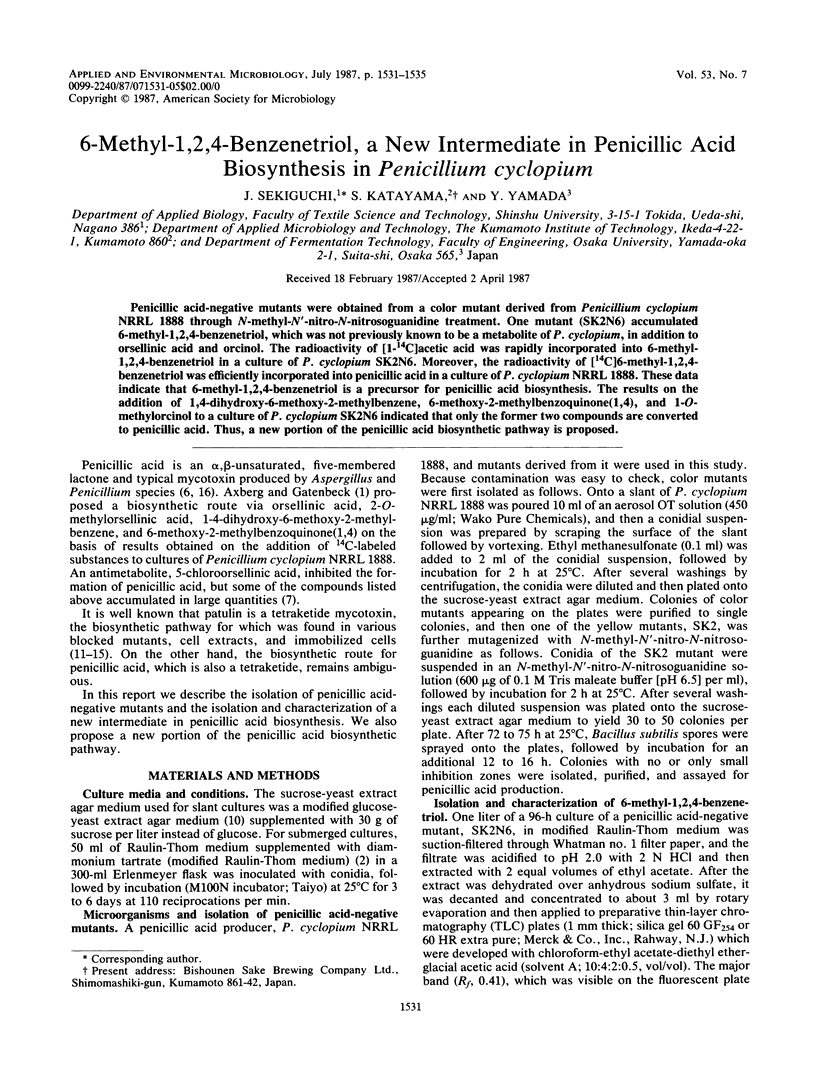Abstract
Penicillic acid-negative mutants were obtained from a color mutant derived from Penicillium cyclopium NRRL 1888 through N-methyl-N'-nitro-N-nitrosoguanidine treatment. One mutant (SK2N6) accumulated 6-methyl-1,2,4-benzenetriol, which was not previously known to be a metabolite of P. cyclopium, in addition to orsellinic acid and orcinol. The radioactivity of [1-14C]acetic acid was rapidly incorporated into 6-methyl-1,2,4-benzenetriol in a culture of P. cyclopium SK2N6. Moreover, the radioactivity of [14C]6-methyl-1,2,4-benzenetriol was efficiently incorporated into penicillic acid in a culture of P. cyclopium NRRL 1888. These data indicate that 6-methyl-1,2,4-benzenetriol is a precursor for penicillic acid biosynthesis. The results on the addition of 1,4-dihydroxy-6-methoxy-2-methylbenzene, 6-methoxy-2-methylbenzoquinone(1,4), and 1-O-methylorcinol to a culture of P. cyclopium SK2N6 indicated that only the former two compounds are converted to penicillic acid. Thus, a new portion of the penicillic acid biosynthetic pathway is proposed.
Full text
PDF




Images in this article
Selected References
These references are in PubMed. This may not be the complete list of references from this article.
- Axberg K., Catenbeck S. Intermediates in the penicillic acid biosynthesis in Penicillium cyclopium. Acta Chem Scand B. 1975;29(7):749–751. doi: 10.3891/acta.chem.scand.29b-0749. [DOI] [PubMed] [Google Scholar]
- BENTLEY R., KEIL J. G. Tetronic acid biosynthesis in molds. II. Formation of penicillic acid in Penicillium cyclopium. J Biol Chem. 1962 Mar;237:867–873. [PubMed] [Google Scholar]
- Better J., Gatenbeck S. 1,4-dihydroxy-2-methoxy-6-methylbenzene, a metabolite of Penicillium baarnense. Acta Chem Scand B. 1976;30(4):368–368. doi: 10.3891/acta.chem.scand.30b-0368. [DOI] [PubMed] [Google Scholar]
- Chapman P. J., Ribbons D. W. Metabolism of resorcinylic compounds by bacteria: orcinol pathway in Pseudomonas putida. J Bacteriol. 1976 Mar;125(3):975–984. doi: 10.1128/jb.125.3.975-984.1976. [DOI] [PMC free article] [PubMed] [Google Scholar]
- Packter N. M., Collins J. S. Effect of inhibitors of protein synthesis on the formation of phenols derived from acetate and shikimic acid in Aspergillus fumigatus. Eur J Biochem. 1974 Feb 15;42(1):291–302. doi: 10.1111/j.1432-1033.1974.tb03339.x. [DOI] [PubMed] [Google Scholar]
- Sahasrabudhe S. R., Lala D., Modi V. V. Degradation of orcinol by Aspergillus niger. Can J Microbiol. 1986 Jul;32(7):535–538. doi: 10.1139/m86-099. [DOI] [PubMed] [Google Scholar]
- Sekiguchi J., Gaucher G. M. Conidiogenesis and secondary metabolism in Penicillium urticae. Appl Environ Microbiol. 1977 Jan;33(1):147–158. doi: 10.1128/aem.33.1.147-158.1977. [DOI] [PMC free article] [PubMed] [Google Scholar]
- Sekiguchi J., Gaucher G. M. Identification of phyllostine as an intermediate of the patulin pathway in Penicillium urticae. Biochemistry. 1978 May 2;17(9):1785–1791. doi: 10.1021/bi00602a033. [DOI] [PubMed] [Google Scholar]
- Sekiguchi J., Gaucher G. M. Isoepoxydon, a new metabolite of the patulin pathway in Penicillium urticae. Biochem J. 1979 Aug 15;182(2):445–453. doi: 10.1042/bj1820445. [DOI] [PMC free article] [PubMed] [Google Scholar]
- Sekiguchi J., Gaucher G. M. Patulin biosynthesis: the metabolism of phyllostine and isoepoxydon by cell-free preparations from Pencillium urticae. Can J Microbiol. 1979 Aug;25(8):881–887. doi: 10.1139/m79-131. [DOI] [PubMed] [Google Scholar]
- Sekiguchi J., Shimamoto T., Yamada Y., Gaucher G. M. Patulin biosynthesis: enzymatic and nonenzymatic transformations of the mycotoxin (E)-ascladiol. Appl Environ Microbiol. 1983 Jun;45(6):1939–1942. doi: 10.1128/aem.45.6.1939-1942.1983. [DOI] [PMC free article] [PubMed] [Google Scholar]



